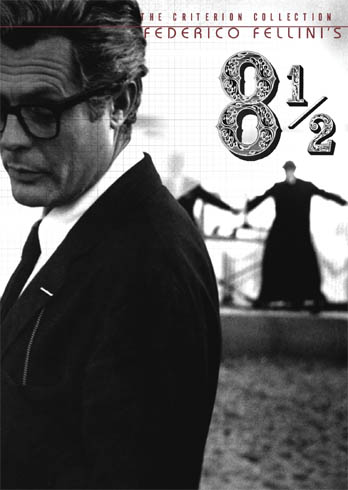
|
At one point in Frederico Fellini’s 8 1/2 Guido, an idealistic film Director, sits in his car, staring at the towering skeleton of a set for his now abandoned film. Sitting in the passenger seat is a film critic consultant, telling him this is all for the best, that it was better to let the film die, unfinished, than leave such a failure in his cannon:
“We critics… do what we can. Our true mission is sweeping away the thousands of miscarriages that everyday… obscenely… try to come to the light. And you would actually dare leave behind you a whole film, like a cripple who leaves behind his crooked foot print. Such a monstrous presumption to think that others could benefit from the squalid catalogue of your mistakes!”
This is the film’s “Ah-Ha” moment.
But to understand how we got here: The film opens with Guido Anselmi returning from a two week lapse in his most recent film’s production. The production is on hold, apparently due to Guido’s inability to articulate what his film is about. He hires on a deeply pessimistic film critic, Daumier, to analyze his screenplay, and the man holds it in complete contempt, but this is only one of Guido’s problems. Surrounding the Director is an entourage of characters, a Producer, an aging Actress, Magazine Writers, Set and Costume Designers, his wife, his mistress, all demanding his time, pulling his attention this way and that.
This film falls into a subcategory of avandt garde cinema that is reflective, self-critical. Throughout the film, characters comment on the director’s style, as when his Doctor asks him if he’s making “another film without hope?”
Others ask after his purpose, “I’ve figured out what you’re trying to talk about,” his Producer tells him, “Man’s inner confusion. But you’ve got to be clearer.”
The film crew even has a professional critic, Daumier, like an artistic conscience, providing a running commentary on the production’s pretentiousness. “The film lacks a problematic or a philosophical premise,” he warns, “making the film a series of gratuitous episodes.”
The film is brimming with women. There is Carla, his bubbly mistress who reads Donald Duck. She contrasts with his wife, Luisa, serious and business like. There is the grotesque and sexually charged Saraghin. The wild and exotic Gloria. Madeleine, the aging French actress. The virgin Mary. Each woman beautiful and desirable in her own uniqueness.
Many of these women ask Guido why he never makes Romances. The answer seems to stem from the prevalent culture of Catholicism running throughout his life and the shame of lust. There is also Guido’s infidelity, and the lying at which he is so pathetically inept. This brings us to film as a lie and Guido’s struggling desire to tell the truth, if only the truth did not hurt other’s so. But these are all, ultimately, fragments of a painting, none of which capture the whole.
This world is Guido’s perspective as an artist, his brain forever muddling away about how to complete his most important work. As a result, even when we are firmly grounded in reality, the film is surreal. Voices are dubbed, poorly. Are we are hearing what the character’s are saying, or what Guido hears?
The film is nostalgic, apologetic, beautiful, fantastic, romantic, but as a blur of moments, trying to articulate something that language cannot hope to convey. The film’s original title “La Bella Confusione” (The Beautiful Confusion), seems very apropos considering its prevalent theme. As the critic argues, the world is confusing, and therefore meaningless. Optimism holds no place in it.
At that moment, near the end, when the critic espouses his fatalistic point of view and we see Guido staring off into the distance, a parade of nostalgia taking place before his mind’s eye, everything becomes clear. The critic helps us see it.
Not because he is right, but because of how very wrong he is.
Similar Films: Adaptation, Deconstructing Harry, CK-1